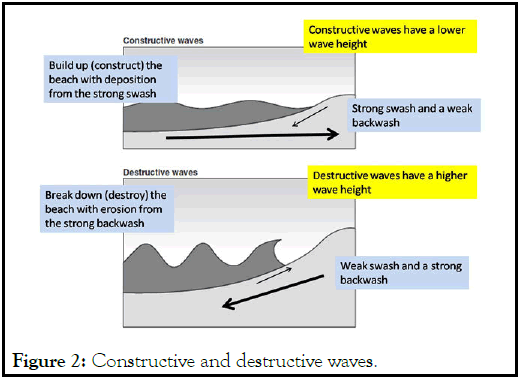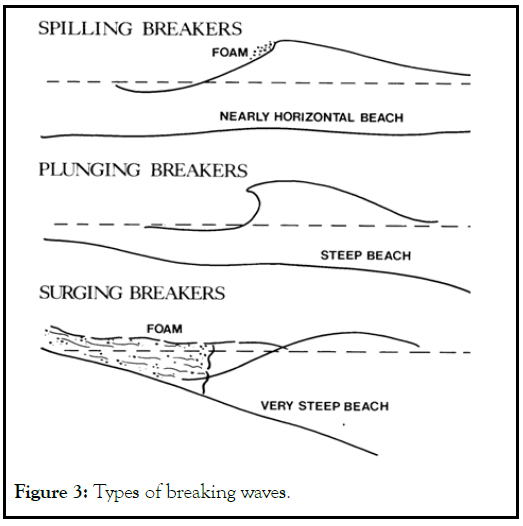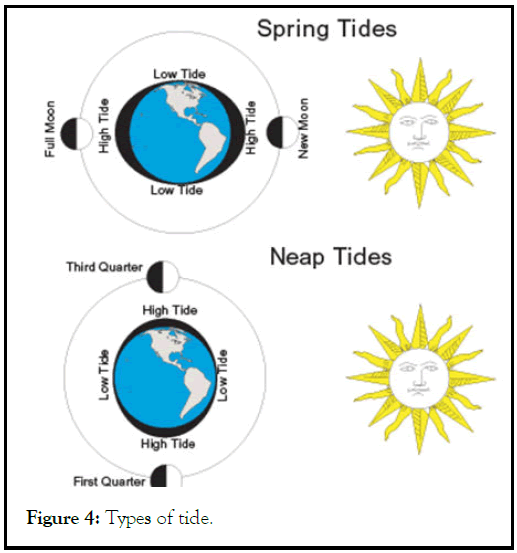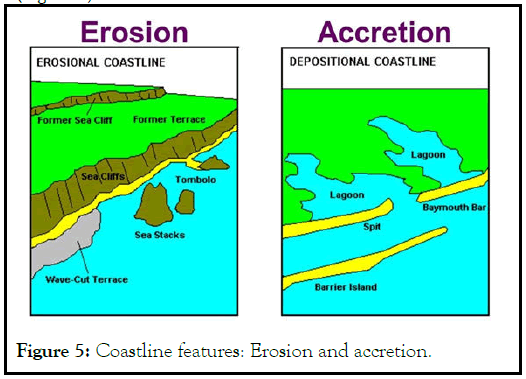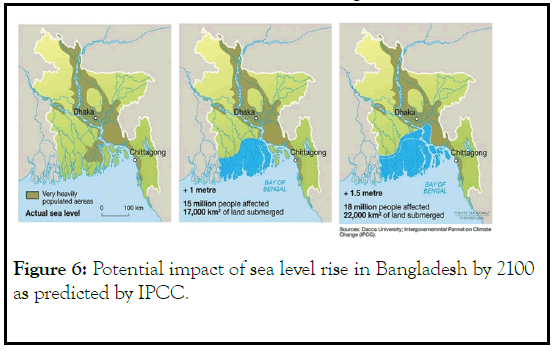Indexed In
- SafetyLit
- RefSeek
- Hamdard University
- EBSCO A-Z
- OCLC- WorldCat
- Publons
Useful Links
Share This Page
Journal Flyer

Open Access Journals
- Agri and Aquaculture
- Biochemistry
- Bioinformatics & Systems Biology
- Business & Management
- Chemistry
- Clinical Sciences
- Engineering
- Food & Nutrition
- General Science
- Genetics & Molecular Biology
- Immunology & Microbiology
- Medical Sciences
- Neuroscience & Psychology
- Nursing & Health Care
- Pharmaceutical Sciences
Research Article - (2021) Volume 0, Issue 0
Coastal Forces and Processes
Sadia Afrin Kamal*Received: 25-Oct-2021 Published: 15-Nov-2021
Abstract
Coastal zone is where the ocean, land and sea interact with each other. It is a very active and dynamic area where continuous coastal forces like-wind, erosion, tides, sea level rise are seen. These forces help to create various coastal phenomena and landforms that are important for the environment as well as biological diversity. So these forces and processes impact not only the people living in the coastal environment but also their livelihoods. The coastal zone of Bangladesh covers about 32% of the total area landmass which includes a total of 19 districts. This article describes the different types of activities undertaking in the coastal environment and how these actions have an influence on the costal life directly or indirectly.
Keywords
Coastal zone; Coastal forces and processes; Effects of coastal processes
Introduction
About 70% of the earth’s surface is covered by water, and the coast, which forms the interface between land and water, is the site of an array of geographic processes and a range of landforms. Coastal ecosystems are good habitats for innumerable amount of flora and fauna, including salt marshes, mangroves, sea grass and coral reefs. Coastal areas are unique and typical landmasses bordered by the sea and ocean. Coastal zones are very sensitive and are not static but rather dynamic environments that involve transformation mass and energy through different forces, producing rocky coasts as well as beaches, dunes, barriers and tidal inlets. These forces and processes involve movement and dissipation of large amounts of energy capable of causing rapid and spectacular changes in landforms along coasts. The major environmental conditions affecting coasts are geology, sediment supply/characteristics and external energy sources (winds, waves and tides). Human activity is an emerging forcing factor on most coats worldwide.
The 3 principle marine processes that influence coasts are:
• Transportation-when waves and tides transfer broken, eroded materials somewhere else.
• Erosion-breaking down of the land by the force of waves.
• Disposition-process by which winds and tides lose energy, cease to transport and release eroded materials, thus depositing them.
• These processes are driven by various types of driving forces such as Wind, Waves, Tides, Currents, Coastal erosion and accretion Sea level rise [1].
Wind
Wind is the primary key to almost all other coastal processes. It plays a vital role in shaping and changing the coastal environment. It is also the major generating and sustaining force of waves. The several effects of wind on coastal geomorphology also includes wind stress on the water surface in major storms such as hurricanes and typhoons, storm surges, upwelling and down-welling processes in the coastal ocean and sea breeze effects.
Waves
Waves are the dominant force driving the nature of a beach. The energy carried through waves moves beach sediment and transforms beach shape. The more energy, the greater the extent of change. Waves get their energy from the wind. As the wind blows over the surface of the sea, it creates friction. This frictional drag causes water particles to rotate and their energy is transferred forward in the form of a wave. The amount of energy carried through a wave can be determined by the wave structure (Figure 1). Waves are characterized by-
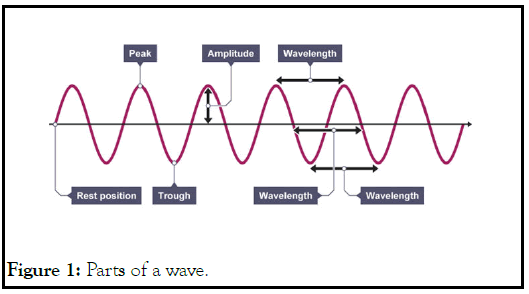
Figure 1: Parts of a wave.
• Crests or peaks: High spots of a wave.
• Troughs: Low spots of a wave.
• Wavelength: The horizontal distance between two crests or troughs.
• Wave height: The difference in height between a crest and a trough.
• Velocity: The rate of forward motion of the wave peak.
• Period: The time between successive crests passing the same point.
• Fetch: The distance over water that the wind blows in a single direction.
• Amplitude: The maximum positive displacement from the undisturbed position of the medium to the top of a crest.
When waves breaks, the water rushes up towards the elevated parts of the beach. This movement is called the swash. And when it comes down slowly backwards, it is called backwash.
There are 3 main factors that affect the strength of a wave:
• The strength and speed of the wind
• The duration of the wind
• The fetch
Wind-generation of waves involves a transfer of energy from moving air to water surface (Summerfield 1991). Waves are also generated by low atmospheric pressure (storm surges) and displacement of the ocean floor, in particular by earthquakes (tsunami). Within the surf-zone, waves are the major mechanism for sand movement, therefore coastal sedimentation and longshore drift. Each wave type has a different effect on shoreline weathering and coastal erosion. Waves are capable of creating two types of processes-(a) Constructive waves and (b) Destructive waves.
Constructive waves: They are created in calm weathers and are less powerful than destructive waves. They break on the shore and deposit materials, building up beaches [2]. They have a long wavelength and are low in height.
Destructive waves: They are created from big, strong waves when the wind is powerful. They tend to erode the coast, where wave has traveled over a long fetch. They have a short wavelength (Figure 2).
Figure 2: Constructive and destructive waves.
Another type of wave can be seen near the coast shoreline that are called breaking waves. Breaking waves generally occur in the surf zone where the amplitude reaches the point where the crest of the wave actually overturns. The 4 basic types of breaking water waves, such as-(a) Spilling, (b) Plunging, (c) Surging and (d) Collapsing.
Spilling breakers: Occurs when the ocean floor has a gradual slope.
Plunging breakers: Occurs when the ocean floor has a steep slope, or sudden depth changes, such as from a reef or sandbar.
Surging breakers: Originate from long period, low steepness waves and/or steep beach profiles.
Collapsing breakers: Collapsing waves are a cross between plunging and surging.
Wave breaking leads to an increase in the mean water level which is known as wave setup. As waves break, wave energy is dissipated. This results in a decreasing mass flux, which is balanced by an increasing water level: wave setup. As a consequence, a near-bed return current (undertow) is generated, balancing the onshore mass flux (Figure 3).
Figure 3: Types of breaking waves. Afrin Sk J
Tides
Tides result from the gravitational pull exerted on the ocean water by the sun and moon. Because the moon is closer to Earth, it has more than twice the gravitational effect of the distant sun. The motions of Earth, moon and sun with respect to one another produce semi-diurnal tides along most coasts in which there are two highs and two lows approximately every 24 hours. There are 2 important tides to take note of (1) Spring tide and (2) Neap tide.
Spring tide: The spring tide forms twice in a lunar cycle and increases the tidal range by heightening the high trade mark and lowering the low trade mark. This is caused by the alignment of the sun and moon with their gravitational pull.
Neap tide: The neap tide produces a low tidal range, in that the higher tide is lower than normal and lower tide is higher. This occurs twice in the lunar cycle when the sun and moon are acting against each other (at 900 from each other).
Tides are an important factor in considering coastal processes, as their interaction with the coastal environment to a large extent determines the location of many coastal landforms. Tidal types determine the interval between tides and therefore the time available for the shore to dry after high tide, which is significant for shoreline weathering processes and biological activity. Additionally, tidal type affects the intensity of tidal currents in case of narrow coastal embayments where tidal flows are concentrated.
The major impact of tides is to shift the shoreline between high tide and low tide, and to generate tidal currents either parallel to the coast, or at tidal inlets and estuaries, currents flowing into the inlets and perpendicular to the coast (Figure 4).
Figure 4: Types of tide.
Currents
Ocean currents are continuous, direct movements of ocean water driven by winds, water density and tides. Earth’s rotation results in the Coriolis effect which also influences ocean currents. These currents are located at both the ocean surface (surface currents) and in deep water below 300 meters (deep currents).
Currents in coastal seas are divided into 5 categories-
Tidal currents: Tidal currents are strongest in large water depths away from the coastline and in straits where the current is forced into a narrow area.
Wind-generated currents: These currents are caused by the direct action of the wind shear stress on the surface of water. These are normally located in the upper layer of the water body.
Storm surge: It is the current generated by the total effect of the wind shear stress and barometric pressure gradients over the entire area of water affected by a specific storm.
Currents in nearshore zone, which are largely responsible for most coastal sediment movement and changing the landforms, are of 2 types-
Shore-parallel or longshore currents: It is the dominant current in the nearshore zone. It is generated by waves breaking at an angle to the beach and form changes in water levels along the shoreline and transport sand in, out and along a beach.
Near-shore currents: Nearshore currents help to move sand in the nearshore zone, they also transport water shoreward as waves break and help to rebuild beaches after storm erosion.
Coastal erosion and accretion
Coastal erosion is the loss or displacement of land, or long-term removal of sediment and rocks along the coastline due to the action of waves, currents, tides or other impacts. In short, it is the loss of coastal lands due to the net removal of sediments or bedrock from the shoreline. Coastal erosion may be caused by hydraulic action, abrasion, impact and corrosion by wind and water and other natural or unnatural forces. Coastal erosion can be either a rapid-onset hazard (occurs very quickly, a period of days to weeks), or a slow-onset hazard (occurring over many years or decades to centuries). Coastal erosion happens in the form of several processes such like:
Hydraulic action: It occurs when waves striking a cliff face compress air in cracks on the cliff face. This exerts pressure on the surrounding rock and can progressively splinter and remove pieces.
Attrition: It occurs when waves cause loose pieces of rock debris to collide with each other and progressively become smaller and rounder.
Solution: It is the process in which acids contained in sea water will dissolve some types of rock, such as chalk or limestone.
Abrasion: This process occurs when waves break on cliff faces and slowly erode it.
Corrosion: Also known as solution/chemical weathering occurs when the sea’s pH (below pH 7.0) corrodes rocks on a cliff face.
Accretion is the seaward build-up of coastal land that occurs when the supply of sediment is greater than the erosive impacts of sea level rise and prevailing wave and wind conditions. It is an unusual phenomenon on barrier islands anywhere in the world other than spits or islands associated with major river deltas. So accretion is basically a process opposite of erosion. If a coastline is not in a healthy sustainable state, erosion can be more serious and accretion does not fully restore the original value of the visible beach or foreshore, which leads to permanent beach loss (Figure 5).
Figure 5: Coastline features: Erosion and accretion.
Sea level rise
Sea level rise is an increase in the level of the world’s oceans. It is caused primarily by two factors related to global warming: the added water from melting ice sheets and glaciers and the expansion of seawater as it warms. Rise of sea level poses a serious threat to coastal life around the world. Consequences include increased intensity of storm surges, flooding and damage to coastal areas [3].
UNEP (1989) showed 1.5 m sea level rise in Bangladesh coast by 2013, affecting 22,000 sq. km area with a population of 17 million affected. However subsidence is also a considerable factor for sea level rise in Bangladesh. In this case it has been noted that Ganges and Brahmaputra deliver approximately 1.6 billion tons of sediment annually to the face of Bangladesh [4]. These sediments compensate the natural compaction and subsidence of the delta and keep its size stable, relatively. So sediment replenishment is considered to balance subsidence of the delta that results a net sea level rise (Figure 6).
Figure 6: Potential impact of sea level rise in Bangladesh by 2100 as predicted by IPCC.
Effects of coastal processes on the environment
Powerful waves can cause severe erosion problems along the coastal areas. All coastlines are affected by storms and other natural events that cause erosion; the combinations of storm surge at high tide with additional effects from strong waves create the most damaging conditions. On coastal headlands, erosion can lead to undercutting of cliffs and steep slopes and contribute to mass wasting [5].
Ocean currents are an important abiotic factor that significantly influences food webs and reproduction of marine organisms and the marine ecosystems that they inhabit.
Upwelling currents bring cold nutrient-rich waters from the ocean bottom surface, supporting many of the most important fisheries and ecosystems in the world. Tidal currents erode and transport sediments and thus play an increasingly important role in local circulation near shore.
Erosion removes the topsoil from the ground, often removing the seed bank that exists within soils. Further, this can introduce toxins from pesticide and fertilizer applications into waterways. The combination of sea-level rise, land subsidence and isostatic rebound creates both emergent and submergent coasts.
Rising sea levels will probably remove large areas of rich biological habitat represented by existing coastal dunes, estuaries and marshlands. Associated impacts may include changed water quality, accumulation of wrack, retention of nutrients and other contaminants. Moreover, the process of salinization and coastal inundation has been exacerbated by rising sea levels.
Conclusion
Coastal processes shape the physical environment, providing habitat such as nesting beaches, reefs and mangrove forests or seagrass beds. It also influences the hydrodynamics of an area which, in turn, determine the ecological communities which are able to establish in the coastal zone as well as critical life cycle processes such as coral or fish spawning and recruitment. These processes should be one of the main issues in coastal zone management; it is important to analyze the coastal structures and discuss the impacts on them provided can serve as warning to save the environment in the future, or at least, decrease the negative effects. Impacts to coastal processes can result in changes to the factors marine environmental quality, benthic communities and habitats, marine Fauna, landforms, inland waters environmental quality, terrestrial flora and vegetation, terrestrial fauna and social surroundings. The protection and management of coastal areas should be supported by deep knowledge of the coastal processes and of the interaction between water motion, seabed topography and coastal structures.
REFERENCES
- Gerd M, Michael H, Jasper K. Introduction to coastal processes and geomorphology (2nd edition). 15-20.
- Giuseppe B. Management and protection of coastal area, the importance of coastal processes during the planning phase. Air Soil Water Res. 2013; 6.
- Begum S, Fleming G. Climate change and sea level rise in Bangladesh, part II: Effects. 2009
- Arfan Md. Impact of sea level rise in the coastal areas of Bangladesh: A macroeconomic analysis. J Econ Dev. 2014; 5(18).
- Andrew D. Coastal processes and beaches. Nature Education Knowledge. 2012; 3(10):15.
Citation: Afrin Sk (2021) Coastal Forces and Processes. J Coast Zone Manag. S5:002.
Copyright: © 2021 Afrin Sk. This is an open-access article distributed under the terms of the Creative Commons Attribution License, which permits unrestricted use, distribution, and reproduction in any medium, provided the original author and source are credited.

